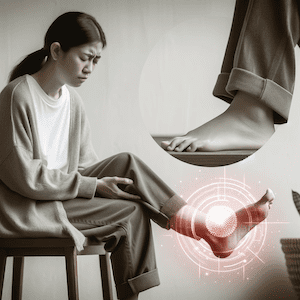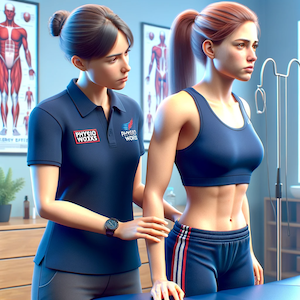Relative Energy Deficit in Sport (RED-S)
Article by Grace McMahon

Nourishing Athletic Excellence: Insights from the IOC’s 2023 Consensus on RED-S
Introduction
In the competitive world of sports, reaching peak performance is the gold standard for athletes. This goal demands a fine balance of training, recovery, and dietary support. Recognising this, the International Olympic Committee (IOC) issued a detailed consensus statement on Relative Energy Deficiency in Sport (RED-S) in 2023, marking a pivotal advancement in athlete health.
What is RED-S?
RED-S emerges when an athlete’s energy intake fails to cover the energy spent on training, competition, and basic bodily functions. It’s a complex syndrome with wide-ranging physical and psychological effects, severely hampering health and performance.
What are the Symptoms of RED-S?
The symptoms of Relative Energy Deficiency in Sport (RED-S) can vary widely but generally include a combination of physiological and psychological signs. These symptoms result from inadequate energy intake to meet the demands of energy expenditure required for training, competition, and the normal functioning of the body. Key symptoms in females include:
- Menstrual Dysfunction: This can range from irregular menstrual cycles to amenorrhea (the absence of menstruation). It’s one of the most common and early signs of RED-S.
- Bone Health Issues: Decreased bone mineral density, leading to an increased risk of stress fractures and osteoporosis. This is often related to the hormonal imbalances caused by low energy availability.
- Fatigue: Persistent tiredness and lack of energy not relieved by rest, impacting training performance and daily activities.
- Weight Loss: Unintentional weight loss or an inability to gain weight appropriate to growth and development needs.
- Poor Performance: A noticeable decline in sports performance, including endurance, strength, and recovery times.
- Mood Changes: Increased prevalence of depression, anxiety, and irritability, often related to the psychological stress of managing training and dietary intake.
- Decreased Immune Function: More frequent illnesses and infections, indicating compromised immune health.
- Altered Metabolic Rate: Changes in metabolic rate as the body tries to conserve energy due to insufficient intake.
- Eating Disorders: Symptoms of disordered eating or full-blown eating disorders may be present, as RED-S can be both a cause and effect of such conditions.
It’s important to note that these symptoms can have significant long-term health consequences if not addressed. Early recognition and intervention by healthcare professionals, including physiotherapists, dietitians, and sports medicine specialists, are crucial for the effective management and prevention of RED-S.
What are the Consequences of RED-S?
The consequences of Relative Energy Deficiency in Sport (RED-S) can be wide-ranging and significantly impact an athlete’s health, well-being, and performance. RED-S results from an imbalance between energy intake and the energy expended in training and daily activities, leading to insufficient energy available for the body’s normal functions. The consequences of RED-S include:
- Bone Health: Reduced bone mineral density and an increased risk of stress fractures and osteoporosis due to lower estrogen levels in females and changes in bone metabolism markers in males.
- Menstrual Function: In females, RED-S can lead to irregular menstrual cycles or amenorrhea, which can have long-term consequences on reproductive health.
- Cardiovascular Health: Potential negative impacts on heart health, including changes in structure and function, and an increased risk of cardiovascular disease due to altered lipid profiles and endothelial function.
- Metabolic Rate: A reduction in metabolic rate as the body attempts to conserve energy, which can complicate efforts to normalise energy balance.
- Immune Function: Impaired immune function, leading to an increased risk of infections and illnesses, as the body lacks the energy to support a healthy immune response.
- Psychological Health: Increased risk of psychological problems, including eating disorders, depression, anxiety, and low self-esteem, often exacerbated by the pressures of sport and performance expectations.
- Growth and Development: In adolescent athletes, RED-S can impair normal growth and development due to hormonal imbalances and inadequate nutrition.
- Endocrine Function: Hormonal imbalances including reductions in hormones such as IGF-1, oestrogen, testosterone, and thyroid hormones, which can affect various bodily functions and overall health.
- Muscle Function: Decreased muscle strength and endurance, impacting athletic performance and increasing the risk of injuries.
- Performance Decline: Overall decline in athletic performance due to compromised physiological and psychological functions, including reduced endurance, strength, concentration, and coordination.
- Long-term Health Consequences: Beyond immediate health and performance issues, RED-S can lead to long-term health consequences, including increased risks of cardiovascular disease, infertility, and osteoporosis.
Addressing RED-S requires a multidisciplinary approach involving nutritionists, physiotherapists, sports medicine professionals, and mental health specialists to ensure athletes receive comprehensive care that addresses both the physical and psychological aspects of the syndrome.

2023 IOC Consensus Highlights
- Broadened Definition of RED-S
The latest consensus expands our understanding of RED-S, highlighting its impact across genders, sports, and age brackets. It underscores the syndrome’s broad spectrum, including hormonal, metabolic, and psychological dimensions. - Risk Identification and Screening
Early detection of at-risk athletes is key. The IOC’s new RED-S Clinical Assessment Tool-Version 2 (IOC REDs CAT2) aims for more effective early screening. Coaches, medical staff, and athletes themselves are crucial in spotting early signs. - From Female Athlete Triad to RED-S
The term “Female Athlete Triad” has been replaced by RED-S to reflect its relevance to all athletes. This change underscores the need for further research into RED-S’s effects on male athletes. - Effects on Performance and Health
RED-S can trigger a range of issues from metabolic dysfunction and weakened immunity to menstrual irregularities and bone health problems. Its impact can extend beyond an athlete’s career, influencing long-term well-being. - Nutritional Interventions
The consensus stresses nutrition’s role in both preventing and managing RED-S. It highlights the importance of carbohydrate intake for energy balance. Collaborating with dietitians and focusing on nutrient-rich foods are emphasised for maintaining health. - Educational Efforts
The IOC calls for increased awareness around RED-S among the sports community. Educational programmes are vital for changing the narrative around nutrition and health, making it easier for athletes to seek support.
Conclusion
The 2023 IOC consensus on RED-S offers a comprehensive approach to understanding and combating the challenges of energy deficiency in athletes. With a focus on screening, nutrition, and education, it aims to protect athletes’ health and ensure their success. Implementing these guidelines is critical for nurturing a supportive environment that promotes enduring athletic achievements.
Related Articles
- Biomechanical Analysis: Key To Injury Prevention: Learn how biomechanical analysis can prevent injuries that might be compounded by conditions like RED-S.
- Sports Health: Essential Guide For Athletes’ Safety: Gain insights into maintaining athlete health.
- Sports Injury Management: Understand the role of physiotherapy in managing sports injuries.
- Triathletes: Explore the unique challenges faced by triathletes, including the risk of RED-S, and how to manage them.
- Cycling Injuries: Essential Tips For Prevention & Safety: Cyclists can learn about injury prevention and the importance of energy balance to avoid RED-S.
- Ballet Injuries Prevention: A Physio’s Guide: Ballet dancers can find strategies for injury prevention and understand the injury risks in high-performance arts.
- Acute Sports Injury Clinic – This article discusses immediate care for sports injuries, touching on aspects relevant to athletes.
- Racquet Sports – Learn about injuries common in racquet sports and how managing energy intake and expenditure is crucial to avoiding injuries.
- Winter Sports – Discover the challenges of maintaining optimal health and performance in winter sports.
Rochedale - Call 38410277
Book Online: RochedaleSalisbury - Call 32751044
Book Online: SalisburySandgate - Call 32691122
Book Online: SandgateCommon Muscle Injuries
A Physiotherapist's Guide
Introduction
Muscle injuries, presenting as muscle strain, pain or myalgia, are prevalent health issues affecting a wide range of individuals. This detailed guide, from a physiotherapist's perspective, delves into various muscle injuries, elaborating on their management, prevention, and the importance of professional advice. Explore the linked articles for an in-depth understanding of muscle injuries and their effective treatment.
Neck & Back Muscle Injuries: Causes and Solutions
- Back Muscle Pain: This pain often results from prolonged poor posture or physical overuse. Key to relief is engaging in exercises that strengthen the core muscles and improve posture, thereby alleviating the strain on the back.
- Neck Sprain: Caused by sudden, awkward movements, a neck sprain can benefit from a combination of gentle stretches and targeted strengthening exercises to restore flexibility and strength.
- Text Neck: A modern ailment resulting from extended mobile device use, text neck can lead to chronic pain. Regular breaks, posture-awareness, and neck-strengthening exercises are essential for prevention.
- Whiplash: Commonly occurring in car accidents, whiplash requires a careful approach including neck stabilisation exercises and controlled movement to encourage healing and prevent further injury.
Lower Limb Muscle Injuries: Understanding and Treating
- Hamstring Strain: Particularly common among athletes, particularly runners, this strain demands rest initially, followed by a carefully structured rehabilitation program focusing on gradual strength building and flexibility.
- Thigh Strain: Often seen in sports involving sprinting and jumping, thigh strains need a combination of rest, ice, compression, and elevation (RICE) in the initial stages, followed by carefully planned strengthening exercises.
- Groin Strain: This injury requires a nuanced approach, including sufficient rest and targeted exercises, to ensure a safe and effective recovery.
- Calf Muscle Tear: Key to recovery is a balance of rest, gentle stretching exercises, and a gradual return to full activity, ensuring the muscle heals correctly and strength is regained.
Upper Limb Muscle Injuries: Prevention and Care
- Golfer's Elbow and Tennis Elbow: Both these conditions involve inflammation of the tendons and require a rest period, followed by ice therapy and specific exercises tailored to strengthen the affected muscles.
- Corked Thigh: Resulting from direct impacts, these injuries demand immediate application of ice and a controlled, gradual exercise regime for recovery.
- DOMS, Fatigue-Related Cramps & Myalgia: Adequate rest, good hydration, and gentle stretching are crucial in alleviating these conditions.
- RSI: Regular stretching, ergonomic workplace adjustments, and taking breaks are key preventive measures for repetitive strain injury.
Systemic Causes of Muscle Pain: A Holistic View
- Fibromyalgia: This complex condition demands a holistic treatment approach, including exercise routines, stress management techniques, and sometimes medication.
- Rheumatoid Arthritis: Effective management combines medication, gentle exercise, and regular physiotherapy sessions.
Prevention and Management Strategies
- Regular Exercise: Regular physical activity helps maintain muscle strength and flexibility, reducing the risk of muscle injuries.
- Posture Improvement: Good posture, both in motion and at rest, is crucial for preventing muscle strain.
- Proper Warm-up and Cool-down: Adequate warm-up before and cool-down after physical activity is vital in preventing muscle strains and injuries.
- Ergonomic Adjustments: Making ergonomic adjustments at work and during daily activities can significantly reduce the risk of repetitive strain injuries and other muscle-related issues.
- Maintaining a Healthy Weight: Keeping a healthy weight reduces the strain on muscles, particularly in weight-bearing joints.
What to Do? Seeking Professional Advice
Consult a physiotherapist or doctor for personalised advice and treatment plans. Remember, early intervention can significantly improve recovery outcomes and prevent chronic problems.
Conclusion
While muscle injuries are common, effective management and prevention are achievable with the right approach and knowledge. Understanding the causes, symptoms, and various treatments available empowers individuals to take proactive steps in their recovery and prevention. For the most tailored and effective treatment, always seek the guidance of a professional physiotherapist.
Rochedale - Call 38410277
Book Online: RochedaleSalisbury - Call 32751044
Book Online: SalisburySandgate - Call 32691122
Book Online: SandgateCommon Ligament Injuries


Ligament Injury
Ligament injuries frequently occur in various body parts, leading to pain and restricted movement. The most common sites include the knee, ankle, shoulder, wrist, hand, and spine.
Notably, knee injuries like ACL, PCL, MCL, and LCL sprains are prevalent.
Shoulder injuries often involve the AC joint, while wrist and hand issues can include thumb and finger sprains.
Spinal ligament injuries, such as back and neck sprains, and whiplash, are also significant. Understanding these injuries helps in prevention, early detection, and effective treatment.
- Ankle Ligament Injuries
- Knee Ligament Injuries
- Shoulder Ligament Injuries
- Wrist & Hand Ligament Injuries
- Spinal Ligament Injuries
Ankle Ligament Injuries
Ankle injuries often result from sudden twists or rolls, leading to sprains and strains.
Knee Ligament Injuries
Knee ligament injuries are among the most common and can severely impact mobility and quality of life.
- ACL Injury
- PCL Injury
- MCL Sprain
- LCL Sprain
- Posterolateral Corner Injury
- Patella Dislocation
- Superior Tibiofibular Joint Sprain
Shoulder Ligament Injuries
Shoulder ligament injuries can be debilitating, affecting a range of movements.
Wrist & Hand Ligament Injuries
Injuries in the wrist and hand are common, especially in sports and physical activities.
Spinal Ligament Injuries
Spinal ligament injuries can result from various causes, including posture issues and physical impacts.
Related Articles
- Ligament Tear - Common Ligament Injuries: Offers a comprehensive overview of ligament injuries across different body parts, including prevention, early detection, and effective treatment strategies.
- Knee Ligament Injury - A Physiotherapist's Guide & Tips: Provides insights into diagnosing knee pain, covering ligament issues among other concerns, and suggests pain relief methods through exercise and treatment.
- Common Ankle Ligament Injuries: A Physiotherapist's Guide: Discusses the treatment and prevention strategies for ankle ligament injuries, emphasising the importance of early intervention.
- Sprained Ankle Treatment & Recovery Guide: Offers detailed guidance on the recovery timelines for sprained ankles, highlighting the importance of restoring strength, motion, and function for a full recovery.
- Ankle Strapping: Complete Guide To Injury Prevention: Focuses on preventing ankle injuries through effective strapping techniques and discusses conditions like ankle arthritis and biomechanical issues.
- Sub-Acute Soft Tissue Injury: Explores the treatment and recovery process for various ligament injuries, including those affecting the knee, shoulder, wrist, hand, and spine.
- Sprained Thumb Treatment And Recovery Tips: Delivers practical tips for treating and recovering from a sprained thumb, along with general management strategies for wrist and hand pain.







































































